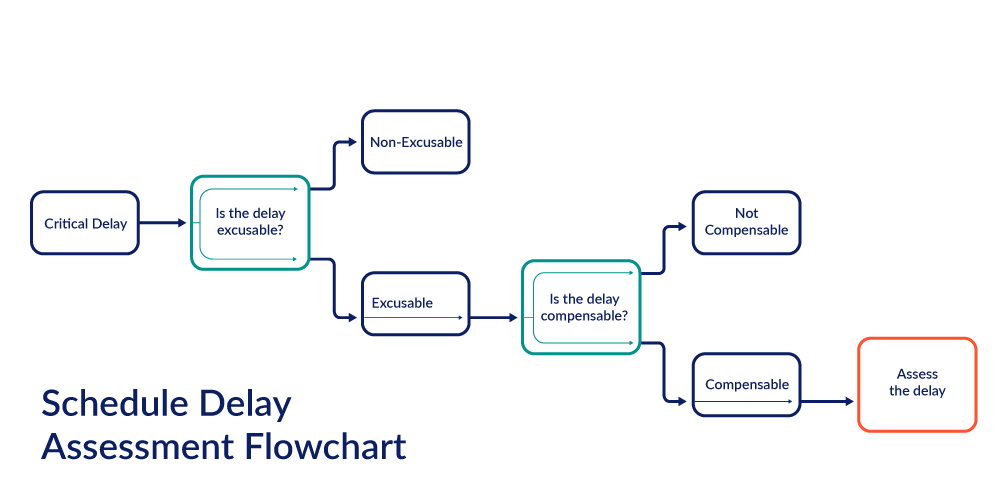
Anyone in the construction trade knows that schedule delays are part of the gig. In fact, 80 percent of construction businesses expect delays on at least some, if not all, of their projects. The Levelset 2020 Report states that one out of every three contractors finishes their projects on time.
While a career batting average of 0.333 will secure your spot in the baseball hall of fame, it’s not so great when it comes to delivering construction projects on time.
The ironic part about project delays is, according to the Levelset 2020 Report, 70 percent of contractors blame poor jobsite coordination for these schedule delays. If that’s true, it means that many delays are avoidable, and affected parties should receive compensation, right?
Let’s take a look at what the different types of schedule delays are, as well as how you can handle them.
The 4 types of schedule delays
There are essentially four types of scheduling delays, and they affect the project and parties on the project differently. The approach to handling them can also vary.
When a delay occurs, you need to determine what type of delay it is and how it will affect the project. While a situation might seem like one type of delay, it could actually fall under two or three. So, don’t underestimate how complex or disruptive a delay can be.

Critical delays
When determining the type of delay you’re dealing with, the first thing you need to consider is if it’s a critical delay.
If a delay affects the project’s completion date, it’s a critical delay. A delay that affects important milestones on the project (which always have the potential to affect the project completion date) can also be a critical delay.
By their nature, you can’t make up for critical delays. Skilled management can minimize the long-term effects, but you can’t completely absorb the delay elsewhere in the project.
The main factor determining whether a delay is critical is if it affects any of the waypoints set by the Critical Path Method (CPM). If a delay prevents or delays reaching any of the CPM milestones, you’ve got a critical delay on your hands.
If you compare your schedule delay against the CPM and there are no changes, you’re dealing with a non-critical delay.
Excusable delays
Once you determine the effect that the delay will have on the project’s timeline, it’s time to assign some blame (well, not really). Rather than jumping straight to laying blame, you need to determine whether the delay is excusable or not.
If your new timeline results from something outside of the contractor’s scope or control, it’s excusable. You can’t hold someone responsible for an aspect of the project that they simply cannot control.
Excusable delays can include things like dangerous or impending weather conditions, customer or owner change orders, hidden issues with the property, or errors in the project specs.
If your analysis determines the delay to be excusable, there should be some compensation or allowance. The deadline might extend to absorb the delay’s effects, or additional funds might be in order — you can’t expect someone to work for free.
On the other hand, inexcusable delays are a whole other animal: These delays are definitely someone’s fault. Whether it’s a sub’s fault for not ordering materials on time, poor planning on the part of the GC, or faulty craftsmanship somewhere in the project, someone specific is to blame.
Compensable delays
While you’re sorting through the delay, you have to determine if someone should receive compensation. Compensation can come in the form of more time, more money, or both.
If the delay affects a party, and that party has nothing to do with causing the delay, it’s likely compensable for that specific party. If the drywallers have to wait because the subcontractor responsible for order insulation made a mistake, the drywallers should receive compensation in the form of a longer deadline (at the least).
In this case, the drywaller’s delay is compensable, but the delay of the sub responsible for the insulation is not — the delay of the sub responsible is also inexcusable.
So what’s the takeaway here? If a delay is excusable, it’s likely compensable too. If it’s inexcusable, it’s probably not compensable.
Concurrent delays
Concurrent delays and their effects are where things get particularly cloudy. Concurrent delays occur when two or more delays occur on a project. These two delays don’t need to occur at exactly the same time but instead happen within a particular window, overlapping each other. They can even be a defense against delay claims.
Think about it this way:
There are two delays, Delay A and Delay B. They’re both critical delays, so they both affect the scheduled completion date. If Delay A occurs and sees resolution, and then Delay B occurs, then they are separate delays. However, if Delay B occurs before Delay A sees resolution, they are concurrent delays.
In this case, the resolution would mean that the delay’s effects are already determined and accounted for.
Concurrent delays can compound the issue, and they’re very difficult to sort through. Determining if either, or both, are compensable or excusable can be extremely challenging.
The good news is, that CSI marathon you binged on over the weekend might not be a complete waste: You’ll probably have to conduct an in-depth analysis to determine what’s what.
Examples of schedule delays
Schedule delays are a lot like snowflakes: No two are exactly alike. There are many ways that a project’s schedule can go sideways.
However, there are some common delays to familiarize yourself with.
Weather delays
Avoiding bad jokes about weathermen always being wrong, the reality is that you simply cannot plan for the weather. Sure, you can tailor your project to start in the spring and end in the fall, but a lot of bad weather that can result in long construction delays can happen in that window.
According to census.gov, the average time to build a single-family home in 2019 was 11.1 months. Just a week of bad weather can throw a project’s entire timeline off — that’s only seven bad days out of over 300.
Budget delays
Budget delays can bring a project to a complete standstill. Whether it’s because the contractor misquoted the estimate, or the owner can’t secure financing, there can be major delays.
Labor scheduling
Construction coordination isn’t always straightforward. A subcontractor managing several projects at once can lead to light crews and delayed timelines.
Lack of communication
Communication is crucial to any construction project. Communication between subs, site management, and the owner is absolutely key for a successful project. Without the proper channels to follow, issues that come up can go unreported or unnoticed. They’ll compound into much larger problems that cause delays.
Site coordination
54 percent of contractors blame delays on poor coordination between subcontractors. The reality is that at some point, most subs’ time on a project consists of sitting around, waiting for another contractor to finish their job — or, worse, waiting on the GC for an approval — before they can proceed.
This downtime adds up into an inefficiency-snowball, tacking days and weeks onto the project. Better coordination and communication can lead to less downtime and faster approvals.
Pandemics
Some delays are entirely out of everyone’s hands, and pandemics are one of them. COVID-19’s effect on the construction industry continues to mount.
At one point, the majority of projects were on hold in some parts of the country. Once sites reopened, labor and materials shortages continue to plague projects, extending their schedules.
5 tips to minimize the effect of construction delays
Regardless of the type of delay you’re dealing with and who’s to “blame,” a delay needs a resolution. Handling schedule delays correctly can make the difference between minimizing their effect and letting the schedule spiral out of control.
1. Set realistic expectations
Setting an unrealistic deadline or budget doesn’t do anyone any good. While no one will fault you for being a go-getter, setting a deadline you know will be difficult to meet is setting your project up for failure (or at least a missed deadline).
When you’re running full speed, the slightest slip can cost you your footing. Instead of pushing yourself and your crews at redline, set up realistic goals and timelines that you can both reach, allowing some room to absorb small delays along the way.
2. Update the construction contract
Your contract can help or hurt you in the event of a schedule delay. Be sure to set it up to help by including the common excusable delays in your contract. Be sure they include a force majeure clause, as so many have realized the benefits of one recently.
If there’s one thing to avoid in your contract, it’s a No Damage for Delay clause, which can mean you won’t see any compensation for any delay, excusable or otherwise.
Also, you should outline any changes along the way in by using change orders. A change order essentially acts as the new contract after a change like a delay.
3. Watch your lien & notice deadlines
Schedule delays don’t just affect the flow of work; they can very easily impact payments to contractors, subs, and suppliers on the job, too. If a project delay is causing a payment delay, keep a close eye on your state’s mechanics lien rules.
Each state has deadlines for sending notice and/or filing a mechanics lien. Miss the deadline and you could lose one of the most powerful tools in your payment toolbox.

Protect & speed up every payment
Learn how Levelset can help you easily manage your lien rights on every project to ensure your payments are always protected.
4. Encourage collaboration and transparency
Creating a jobsite atmosphere where subcontractors are comfortable reporting issues to site management can go a long way toward avoiding significant project delays. By creating channels for communication, you’ll create a collaborative and transparent environment where everyone works together to address problems.
The opposite of this environment is a scenario where subs feel like they need to hide issues or handle issues by themselves. This can lead to bigger problems that fall outside of their limited scope, becoming widespread delays.
5. Negotiate
We’ve already established that delays will probably happen on a project. Once you accept that, you can think objectively and come to a creative resolution. Sometimes that creative resolution requires a scheduling adjustment. Other times, creativity might mean adjusting payment terms or amounts.
When you’re willing to negotiate over the terms of a delay, you’re able to minimize its effects on the project and solve it quickly.